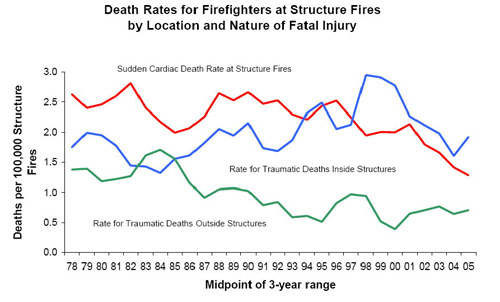Near Misses, Injuries, and Fatalities, Just Part of the Job?
In 2007, twenty firefighters in North America lost their lives due to extreme fire behavior while engaged in interior structural firefighting operations. The United States Fire Administration Report 2007 Firefighter Fatalities in the United States and the NFPA Report Firefighter Fatalities in the United States-2007 provide analysis of firefighter fatalities that occurred during this year. Neither report specifically addressed the issue of firefighter fatalities as a result of extreme fire behavior. In fact the NFPA report classified a significant number of these fatalities as being the result of structural collapse (despite the fact that collapse occurred some time after rapid fire development trapped the firefighters involved).
Thus far in 2008, eight more firefighters have died due to extreme fire behavior while working inside burning buildings. This is the tip of the iceberg! Since January 2008, there have been several incidents in which rapid fire progress trapped multiple firefighters. In each of these incidents the firefighters escaped with serious injuries.
- May 25, 2008 – Four firefighters trapped on the second floor by a flashover, Loudon County, Virginia
- October 7, 2008 – Four firefighters trapped on the second floor by a flashover, Sacramento, California
In What’s Changed Over the Last 30 Years, Fahy, LaBlanc, and Molis state that the rate of traumatic fatalities while engaged in offensive firefighting operations inside burning building has been increasing.
In many cases, extreme fire behavior is a causal or contributing factor. It is critical that firefighters understand compartment fire behavior and can apply that knowledge to maintain situational awareness and make effective decisions on the fireground. Fire behavior training for most firefighters and fire officers is limited to a few hours during recruit academy and possibly brief mention during tactical training. This is not adequate!
At the 2008 International Association of Fire Chiefs Conference in Denver, Colorado, Chief Fire Officer Charlie Hendry of Kent Fire Rescue Service and President of the United Kingdom (UK) Chief Fire Officers Association discussed a number of significant incidents that impacted his nation’s fire service. One of these incidents was a backdraft in townhouse apartment in rural Wales that killed Firefighters Kevin Lane and Stephen Griffin. This incident and the subsequent investigation by the British Fire Brigades Union and the Health and Safety Executive identified major training deficiencies, resulting in changes in fire behavior training across the UK. For a brief overview of the incident and discussion of its impact on the UK fire service, see Blaina: A Perpetual Legacy.
Where is the recognition that the American fire service faces the same problem on an even larger scale?
What can we do, individually and collectively to address this issue? I will be writing about this topic for the next couple of weeks. Add a comment to this post with your ideas!
Ed Hartin, MS, EFO, MIFireE, CFO
Tags: Extreme Fire Behavior, Fire Behavior Training, firefighter fatality, firefighter injury



